Detection of lead ion in water by the reagent extracted from pomegranate peel
Main Article Content
Abstract
This research investigated the potential of pomegranate peel extract as a reagent for detecting lead ions in water. Pomegranate peel was extracted using ethanol as a solvent, and the active compounds were analyzed using LC-MS and UV-Vis techniques. The results revealed the presence of phenolic compounds, specifically gallic acid, and catechins, which are expected to form complexes with lead ions. Lead detection was performed in synthetic wastewater at concentrations ranging from 0.001 to 0.1 M. The findings showed that the pomegranate peel reagent caused a color change from orange to yellow and produced suspended precipitates. The amount of sediment increased proportionally with the concentration of lead ions.
At lead concentrations between 0.01 and 0.1 mg/L, a noticeable color change occurred at the water surface. At 0.05 mg/L, the water surface turned yellow due to the formation of fine suspended sediments, which aligns with the surface water quality standard that limits lead concentration to 0.05 mg/L. These results suggest that pomegranate peel extract can be effectively used for qualitative lead detection in water. This method can serve as a simple tool for monitoring and controlling water pollution while also promoting the utilization of agricultural waste for environmental purposes. If a yellow discoloration is observed on the water surface, it can be inferred that the lead concentration exceeds acceptable levels, indicating the need for water treatment before discharge into community water sources.
Article Details
References
กรกช อินทราพิเชฐ, กนกอร อินทราพิเชฐ และ ศจีรา คุปพิทยานันท. (2555). รายงานวิจัย เรื่อง ทับทิม (Punica granatum) ไทยเพื่อสุขภาพ. มหาวิทยาลัยเทคโนโลยีสุนารี.
กรมควบคุมมลพิษ. (2565). รายงานสถานการณ์มลพิษของประเทศไทย ปี 2565. บริษัท เอพี คอนเน็กซ์ จำกัด.
กรมควบคุมโรค. (2563). แนวทางการเฝ้าระวัง ป้องกันควบคุมโรคพิษตะกั่วในกลุ่มวัยทำงาน. สำนักพิมพ์อักษรกราฟฟิคแอนด์ดีไซน์.
กองยุทธศาสตร์และการวางแผนเศรษฐกิจมหภาค. (2566). ภาวะเศรษฐกิจไทยไตรมาสที่สองของปี 2566 และแนวโน้มปี 2566. สำนักงานสภาพัฒนาการเศรษฐกิจและสังคมแห่งชาติ.
จำลอง ปินตาวงศ์, อานนท์ นนทโส และสถาพร กาวิเนตร. (2554). แนวทางการบริหารจัดการทรัพยากรแร่แมงกานิส ประจำปีงบประมาณ 2554. สำนักทรัพยากรแร่ กรมธรณีวิทยา.
ชมัยพร รอดกลิ่น, เอกรัฐ ศรีสุข และ กล่าวขวัญ ศรีสุข. (2560). ผลของสภาวะการสกัดต่อปริมาณสารประกอบฟี นอลิก สารประกอบฟลาโวนอยด์และฤทธ์ิต้านอนุมูลอิสระของส่วนต่าง ๆ ของส้มซ่า.วารสารวิทยาศาสตร์บูรพา, 1, 211 – 225.
ธนัชสัณห์ พูนไพบูลย์พิพัฒน์. (2562). ผลของความเข้มข้นที่แตกต่างกันของเอทานอลต่อการสกัดสารสกัดหยาบและฤทธิ์ทางอัลลีโลพาธีของใบแก้ว. วารสารเกษตรนเรศวร, 16(1), 1 – 8.
ยุรศักดิ์ นพวงศ์. (2560). วิทยานิพนธ์ เรื่อง การพัฒนาชุดทดสอบเหล็ก โดยใช้สารสกัดจากใบฝรั่ง. มหาวิทยาลัยทักษิณ.
รอฮานา อาดาม. (2558). ศึกษาปริมาณโลหะหนักบริเวณชุมชนประมงบาเละฮิเลในจังหวัดนราธิวาส. มหาวิทยาลัยนราธิวาสราชนครินทร์.
วัชราภรณ์ ประภาสะโนบล และสุนันทา แก้วสระแสน. (2555). ฤทธิ์การต้านอนุมูลอิสระและปริมาณสารฟีนอลิกทั้งหมดของสารสกัดจากใบสิบสองราศี. วิทยาศาสตร์มหาวิทยาลัยราชภัฏเพชรบุรี, 1, 13 – 20.
วัลวิภา เสืออุดม, ระพีพันธุ์ ศิริเดช, วิภาพรรณ ชนะภักดิ์ และ ระพีพร ชนะภักดิ์. (2559). ทับทิมผลไม้เพื่อสุขภาพ. วารสารวิทยาศาสตร์และเทคโนโลยี หัวเฉียวเฉลิมพระเกียรติ, 2, 89 – 100.
วรางคณา เขาดี, ภรทิพย์ จางวาง และวรเชษฐ์ วรรณหลวง. (2563). การตรวจวัดไอออนทองแดงในน้ำ โดยใช้กระดาษกรองดัดแปรด้วยสารสกัดจากเปลือกแก้วมังกรสีขาว. วารสารวิทยาศาสตร์และเทคโนโลยี, 28, 984 – 996.
วาสนา แนมบาง. (2557). การแพร่กระจายโลหะหนักในพื้นที่นาข้าวรอบบ่อฝังกลบขยะกรณีศึกษา ต.วังน้ำ คู้ อ.เมือง จ.พิษณุโลก. มหาวิทยาลัยนเรศวร.
ศรินยา โพธิ์แดง. (2557) การสังเคราะห์อนุภาคเงินนาโนจากเปลือกผลไม้. มหาวิทยาลัยศิลปากร.
แสงโฉม เกิดคล้าย และ ศิรนุช ชั้นอินมนู. (2547). พิษโลหะหนัก. สำนักงานสาธารณสุขจังหวัดพะเยา.
สิริรัตน์ บุญดิเรก, ปรมาภรณ์ จิ๋วพัฒนกุล แก้วมณี, ณัฐพล กิตติคุณเดชา, ณภัทร บุนนาค, ดนุธิดา สาเขตร์ และ สิริลักษณ์ ตีรณธนากุล. (2566). ผลของสารสกัดแทนนินจากเปลือก Garcinia mangostana L. และคลอเฮกซิดีนในการยับยั้งการเจริญของเชื้อสเตร็ปโตคอคคัส มิวแทนส์. วิทยาสารทันตแพทยศาสตร์ มหาวิทยาลัยศรีนครินทรวิโรฒ, 1, 89 – 101.
Bark, K.M., Yeom,J.E., Yang, I.J., Park, O.H., Park,.H.P. & Park, H.R. (2012). Studies on the Interaction between Catechin and Metal Ions. Bulletin of the Korean Chemical Society, 33, 4235 – 4238.
Bodini, M.E., Valle, A., Tapia, R., Leighton, F & Gonzalez, L. (2001). Study of the iron catechin complexes in dimethyl sulphoxide. Redox chemistry and interaction with superoxide radical anion in this medium. Boletin de la Sociedad Chilena de Química, 46(3), 309 – 317.
Dubey, A., & Shiwani, S. (2012). Adsorption of lead using a new green material obtained from Portulaca plant. International Journal of Environmental Science and Technology, 9, 15 – 20.
Freser, F., Hostnik, G., Tosovic, J., & Bren, U. (2021). Dependence of the Fe(II)-Gallic acid coordination compound formation constant on the pH. Foods, 10, 1 – 19.
Hussain, S., Farooqui, M., & Rahim, S.A. (2013). Studies of binary complexes of transition metal ions with Gallic Acid by Potentiometry. International Journal of Emerging Technologies in Computational and Applied Sciences, 13 – 148, 276 – 279.
Li, J., Yu, H., & Luan, Y. (2015). Meta-analysis of the copper, zinc, and cadmium absorption capacities of aquatic plants in heavy metal-polluted Water. International Journal of Environmental Research and Public Health, 12, 14958 – 14973.
Leopoldini, M., Russo, N., & Toscano, M. (2011). The molecular basis of working mechanism of natural polyphenolic antioxidants. Food Chemistry, 125, 288 – 306.
Pollock, J.L., Callaway, R.M., Thelen, G.C. & Holben, W.E. (2018). Catechin–metal interactions as a mechanism for conditional allelopathy by the invasive plant Centaurea maculosa. Journal of Ecology, 97, 1234 – 1242.


